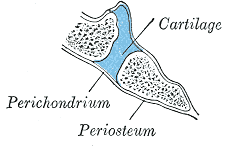Synchondrosis
(Redirected from Synchondroses)
| Synchondrosis | |
|---|---|
| Details | |
| System | Skeletal system |
| Identifiers | |
| TA98 | Lua error in Module:Wikidata at line 746: attempt to index field 'wikibase' (a nil value). |
| TH | {{#property:P1694}} |
| TE | {{#property:P1693}} |
| Anatomical terminology [[[d:Lua error in Module:Wikidata at line 865: attempt to index field 'wikibase' (a nil value).|edit on Wikidata]]] | |
A synchondrosis is a type of cartilaginous joint where the bones are joined by hyaline cartilage. This type of joint is typically found in the skeletal system and is characterized by its immobility or very limited movement. Synchondroses are important during the growth and development of the skeleton.
Structure[edit | edit source]
Synchondroses are composed of hyaline cartilage, which is a translucent type of cartilage that provides support and flexibility. This cartilage is found at the ends of long bones, in the rib cage, and in the nose, among other locations. The primary function of hyaline cartilage in synchondroses is to allow for growth and slight movement during the early stages of development.
Examples[edit | edit source]
One of the most well-known examples of a synchondrosis is the epiphyseal plate (growth plate) found in the long bones of children and adolescents. The epiphyseal plate is responsible for the longitudinal growth of bones. As a person matures, the hyaline cartilage in the epiphyseal plate is gradually replaced by bone, a process known as endochondral ossification, eventually forming a synostosis.
Another example is the joint between the first rib and the manubrium of the sternum. This joint remains a synchondrosis throughout life, providing stability to the thoracic cage.
Function[edit | edit source]
The primary function of synchondroses is to allow for bone growth and development. During childhood and adolescence, the hyaline cartilage in these joints permits the bones to lengthen and grow. Once growth is complete, many synchondroses ossify and become synostoses, which are bony joints with no movement.
Clinical significance[edit | edit source]
Disorders of synchondroses can lead to growth abnormalities and skeletal deformities. For example, premature closure of the epiphyseal plate can result in growth disorders such as dwarfism or gigantism, depending on whether the closure occurs too early or too late.
See also[edit | edit source]
References[edit | edit source]
Translate: - East Asian
中文,
日本,
한국어,
South Asian
हिन्दी,
தமிழ்,
తెలుగు,
Urdu,
ಕನ್ನಡ,
Southeast Asian
Indonesian,
Vietnamese,
Thai,
မြန်မာဘာသာ,
বাংলা
European
español,
Deutsch,
français,
Greek,
português do Brasil,
polski,
română,
русский,
Nederlands,
norsk,
svenska,
suomi,
Italian
Middle Eastern & African
عربى,
Turkish,
Persian,
Hebrew,
Afrikaans,
isiZulu,
Kiswahili,
Other
Bulgarian,
Hungarian,
Czech,
Swedish,
മലയാളം,
मराठी,
ਪੰਜਾਬੀ,
ગુજરાતી,
Portuguese,
Ukrainian
Navigation: Wellness - Encyclopedia - Health topics - Disease Index - Drugs - World Directory - Gray's Anatomy - Keto diet - Recipes
Search WikiMD
Ad.Tired of being Overweight? Try W8MD's physician weight loss program.
Semaglutide (Ozempic / Wegovy and Tirzepatide (Mounjaro / Zepbound) available.
Advertise on WikiMD
WikiMD is not a substitute for professional medical advice. See full disclaimer.
Credits:Most images are courtesy of Wikimedia commons, and templates Wikipedia, licensed under CC BY SA or similar.Contributors: Prab R. Tumpati, MD

